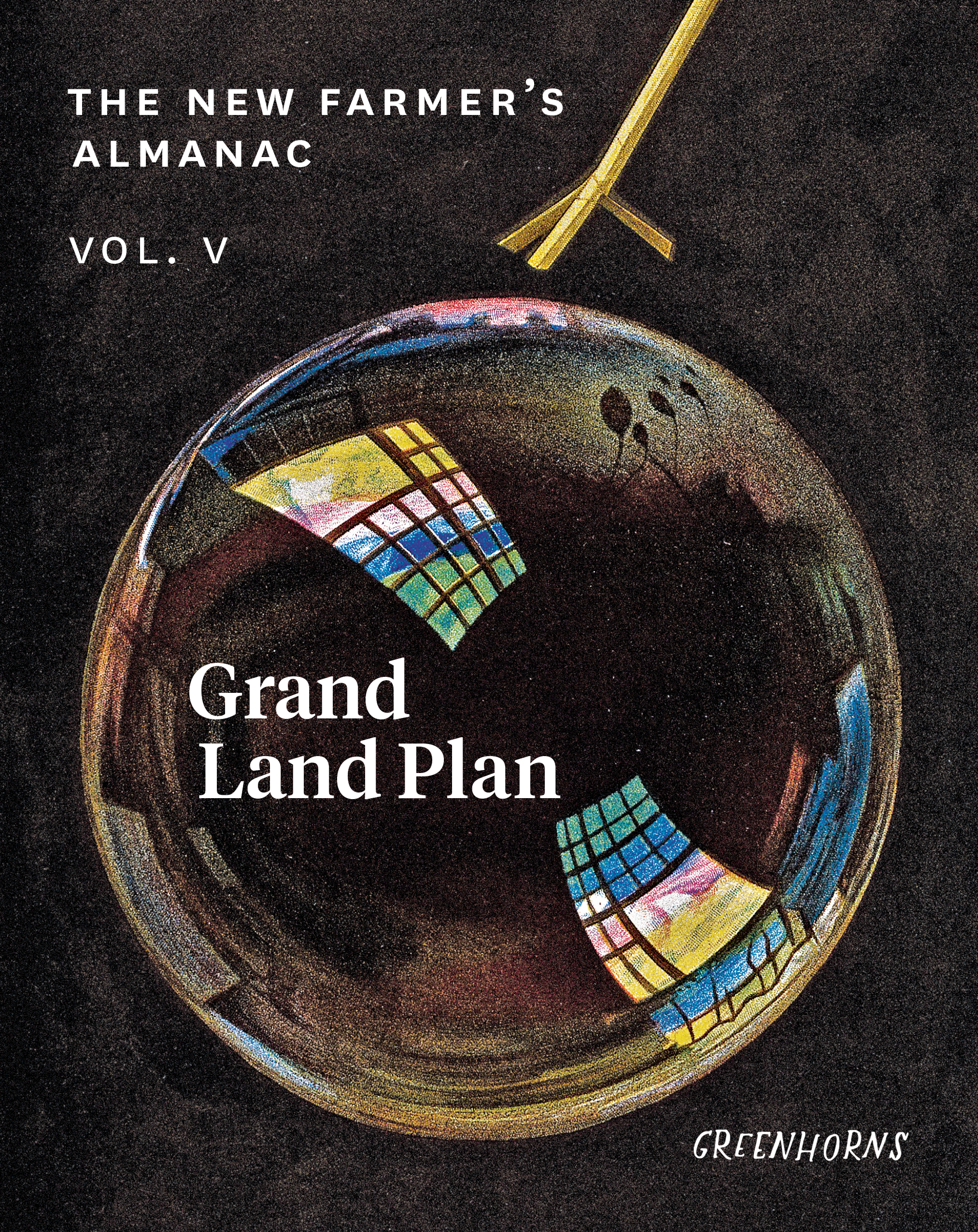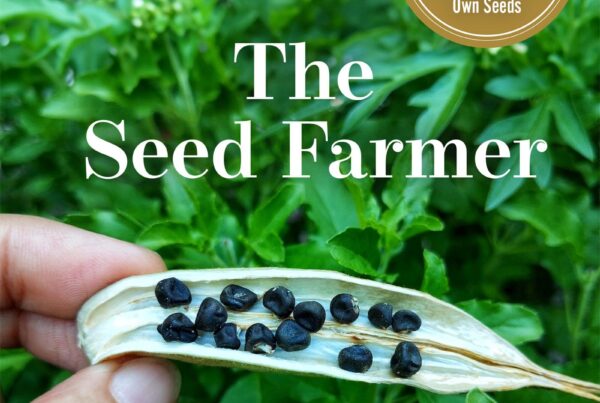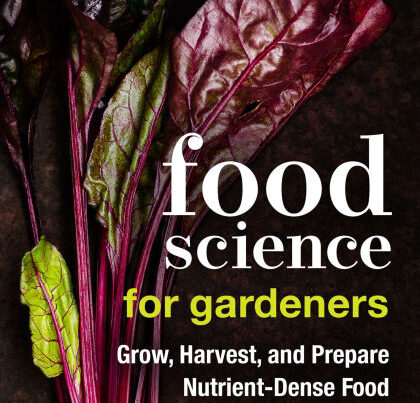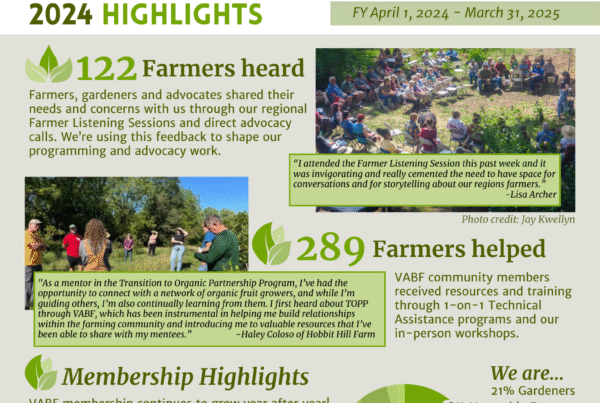Book Review: The New Farmer’s Almanac, Vol V 2021, Grand Land Plan, by the Greenhorns, Feb 2021, 400 pages, softcover, $25, illustrated with B&W photos and drawings. Distributed by Chelsea Green.
This is a great winter treasure trove to dip into by the woodstove after darkness brings you in from the fields. Or to absorb you on snowy days. Or to leave by a frequently visited seat (!) for browsing. It’s a compilation of pictures and writings as an antidote to helplessness. Here you will find reports from the fields, shores, woods, beehives, kitchens, watersheds, and compost piles.
There are historic pieces, such as The Diggers’ Song by Gerrard Winstanley written in 1649, and very current writing on living in a time of racism, Covid, hate crimes, climate disaster and white nationalist surges. This Grand Land Plan is a vision of the future of food systems and land use, put together by farmers, gardeners, poets, activists, grocers, nature-lovers and agitators. Here are solutions to give us hope and ideas on what to do to recover from the challenges, dismantle inequity, restore our chances of a beautiful world. You can browse for what you need each day: poetry, maps, comics, portraits, lessons from honeybees, campaigns for local food, reports of successes, thoughtful prose on the principles and practice for fair and responsive land use for everyone, or a design for a seaweed commons.
The Greenhorns are a group working to promote, recruit and support the next generation of farmers, through publications and events. Covid has led them to use more digital productions, including EARTHLIFE, initially centered in Downeast Maine, along the Pennamaquan River, where the Greenhorns are based in the old Pembroke Iron Works. The group has several ventures in the town, including carpentry, a boat shop, mycological lab, agrarian library, art spaces and living spaces. They offer monthly naturalist trainings.
The contents are divided into monthly sections with a theme. January’s theme is Resistance and Recovery. Small-scale farmers producing healthy food for local eating, have become the envy of many of those in the big cities. The difficulties of 2020 (and 2021) have thrown home food production and working together into a better light, and shown the deep importance of friends and companions. Vegetable seeds sold out, as did CSA shares. Security is in the potato patch, in knowing how to feed your household with what you have on hand, fix things, organize, be a leader – things that truly matter. Not money in the bank, flashy clothes, having a large office.
People have become aware of the fragility of industrial supply chains and the value of local small businesses and the people who work in them. Mutual aid and support, community-based economies, revolving savings and loans, shared healthcare funding groups – all help people get through hard times and thrive. Doing small things that make a difference can empower us to persist and make more differences. As one pioneering farmer says “When we started, we wanted a revolution! . . . Then we realized, it’s the incremental changes that affect a revolution. And then you realize you have had a revolution. You just didn’t see it coming.” The Black communities have long used mutual aid strategies to survive and uplift each other. Black farmer cooperatives have a long history.
We can get hope from reading about reforestation. By the late 1900s, forest area in Denmark had almost rippled since 1800. Swiss forestation had increased from 19% in the 1860s to 32% in the 1980s. Japan, New Zealand, Cuba and Scotland have all undertaken large scale reforestation. An article describes New Zealand’s One Billion Trees Programme, part of a range of initiatives to build a sustainable economy for the people while also meeting their international climate change commitments.
The articles move from political to poetic to practical, and round again. Should farms set aside areas to encourage species diversity, while “sacrificing” the fields with edge-to-edge plowing and cultivation? Or would we do better to incorporate the diversity into the whole of the farm? Here we can probe this question by considering soil life; soil cover; water, nest and shelter functions; flowering plants (food for insects, birds and mammals); native plants; plant structure and composition (diversity); habitat patches and corridors. This leads to thinking about the effects on humans of time in nature. The Japanese have “forest-bathing” therapy. Perhaps it’s time to recognize the value of “farm-bathing” too.
There’s a Hawaiian glossary of terms related to land and water use. You may not need the actual words, but the concepts are such valuable food for thought! There are wise quotes from Kalaninuiliholiho Kamehameha, Ursula Le Guin and Janene Yazzie. There is material to read on pesticide spraying, fishing, pruning, shopping during Covid, cottonwood tree decline and propagation, trapping fish, spruce bark beetles, farming seaweed. Did you know it takes 11-16 years for a 4ft tall rockweed to recover from being cut back 16ins from the holdfast?
Read about capitalism, cooperation, Medieval European land enclosure, colonization, and other forms of land tenure. Elinor Ostrom, who won a Nobel Prize in economics, researched global commons-based resource management systems. She found that each represents a unique set of ways in which people work together to ensure the longevity and health of the resources they depend on. It isn’t the land or the resources that causes commons to succeed, but the process by which people relying on those resources engage with them and with their fellow commoners. Ostrom lists 8 general principles used.
Garrett Hardin’s 1968 infamous essay The Tragedy of the Commons suggests that individuals will destroy the commons by prioritizing their own needs until the system collapses. The assumption is that financial gain is always more important than social networks, or sense of fairness, integrity, or desire to be well-thought-of. Hardin’s theory was not based on research of actual commons-based management systems. Sadly, he is better-known than Ostrom, and the myth that personal ownership is the most effective and logical way to divide resources, is often spoken of as fact.
Sixty miles east of Alaska, the Gwich’in community of Old Crow had to deal during the pandemic with two uninvited visitors from the city of Quebec, seeking refuge, but bringing no gloves, no tools and a risk that they had the virus with them. The community had limited access to healthcare, many vulnerable elders and a bad history of white people bringing in diseases. Members of the Tribal government met them at the airport, isolated them and sent them back.
Many writers thread their politics through their observations. Sheltering in place, working from home, learning to bake sourdough bread and grow kale are not too hard for the privileged, with spacious comfortable housing, outdoor space, computers, desk jobs, and garden space. “By actively and consciously cashing in on my privilege, I have placed myself in an environment in which feeling relief is possible.” (Quinn Riesenman). Others ponder how to shelter in place when unable to earn money to pay for shelter.
I discovered the work of George Washington Carver maybe 10 years ago, when gathering information about growing sweet potatoes. In the Almanac you can read his instructions for growing peanuts, and how to build up worn out soils. Makshya Tolbert has written a eulogy to her late grandmother, who came from Cameroon, in the form of an ode to peanuts. There are photos of recipe cards from Black women in domestic service. A way of establishing an identity.
The Indigenous Corn Keepers Conference of Uchben Kah in January 2020 brought together indigenous farmers to share experience and cultural attitudes about corn. Did you know corn is one of the few plants that can coexist with black walnut?
I loved Ang Roeli’s essay Radicalize the Hive, on what honeybees can teach us about social change. There is proof in Spanish cave paintings that people gathered honey from bee colonies 8,000 years ago. There is evidence of honey-gathering 15,000 years ago, long before farming. The author followed the ritual of “telling the bees” when the Covid pandemic started. “If we come together now, we could get sick, and many of us could die.” Their response was “If we were apart, and could not hold each other, even for a short while, we would most certainly die.” You can read this metaphorically if you prefer. I was taken aback to see the chapter illustrated with a photo of paper wasps, but then, many people are afraid of stinging insects, and don’t look long enough to distinguish one from the other.
Learn about the history of land tenure in Puerto Rico. It is indeed tragic that the lands of the sugar lords were, in many cases, sold to the multi-national seed magnates. 122 years after sugar plantations, the land is still not in the hands of the local people.
Read the September 19, 1942 front page of the Poston Chronicle, published in the Poston, Arizona concentration camp for Japanese-Americans, which was located on the lands of the Colorado River Indian Reservation, against the objections of the Tribal Council. The editorial proposes changes to the co-operative farm management system, with five year leases on a sharecropping basis. Clearly the prisoners didn’t expect to return to their homes in California any time soon.
History is interwoven with memoirs. A Farm Hand’s Perspective explores the challenges and benefits of working on an organic vegetable farm in the Sierra Nevada foothills. “I have no idea how to quantify right livelihood, proximity to nature’s beauty, and the slow pace of seasonal, rural living. The downsides are much easier to count – long hours, low wages, no healthcare – and due to our socialization in a capitalist society, these are easy to fixate upon.”
For a different slant on life, read about developing native plant materials for roadside dust mitigation in southern New Mexico. Yes, people are researching this, and have promising plants that are drought-tolerant, perennial, quick to establish and able to deal with high salt levels.
Michael McMillan writes about a serendipitous meeting on the road with a mycologist and botanist, who taught him to identify wildflowers, cactuses, shrubs and trees, by first identifying the plant family and noting what types grow where. This practice of reading the landscape informed Michael’s career as an ecological landscape designer.
Colleen Perria writes about restoring oak savanna in the southern Great Lakes bioregion. Oaks are fire-resistant and the Native peoples used fire, producing the savanna, with oaks, grasses, flowers and shrubs. But later the land was cleared by settlers to grow field crops. When abandoned, dense young forests grew up. Concrete came later. We falsely “remember” that deep primeval forests occupied the land before the white settlers, when in fact, that land had been a savanna for ages.
Catherine Bennett writes about composting those glossy political candidate flyers, along with dead lambs and reed canary grass. Will the microbes be able to break down the inks and other chemicals, some probably toxic? Journalist Bill Moyer got tested and found he was home to 84 health hazards. Why do we produce so much waste that isn’t safe to be around?
Back to land reform – this time in Scotland. The public has the Right to Roam across private land, provided they do no damage. Between 2003 and 2016, a set of land reform acts established a diversity of alternative land tenure arrangements, intending to reach 100,000,000 acres of community land ownership by 2020. They only managed just over half a million. Parliament reported that 432 individuals in 2013 owned 50% of the private land. But there has been good progress. The entire 5,000-acre island of Ulva was bought by the residents. The Scottish government has supported these transfers, with the message that if you hold title to land, you also have the responsibility to ensure that its use balances your private profit with public good.
How about this for a $64,000 question: “Is fixing trophobiosis the key to beating everything from Coronavirus to locust swarms to climate change?” Trophobiosis is a symbiotic association between organisms where food is obtained or provided. Locust swarms are one symptom of land degradation and poor land management, where trophobiosis has gone awry. Land degradation leads to chronic drought and flooding, followed by soil erosion and loss of organic matter and nutrients, then pest invasions and increased disease levels in crops, livestock and humans. Covid-19 crossed over to humans from wildlife, where the contact was closer than was wise. Synthetic pesticides, herbicides and fertilizers cause imbalances that lead to pest and disease outbreaks. Francis Chaboussou writes about this theory in Healthy Crops: A New Agricultural Revolution. It leads to a unified theory of earth repair.
A traditional Hopi dryland farmer in Arizona describes his heritage crops including corn, beans, melons, squash and gourds. He is in a line of 250 generations of farmers, and knows how to grow food when nature provides 6-10 inches of rain each year. As a youth he worked with his grandfather and studied agriculture at Cornell University. He often wondered at the recommendations in his course. He could not see a need for a 14-row planter. An agricultural economics class explained that American farmers are locked into a cycle that demands high yields (because food prices are low). They are trapped by the financial costs, and the devastating psychological dependence, to need extreme efficiency. Hopi farming is not to make money but to survive and continue their culture. Agriculture and spirituality are closely linked. Despite more than 2,000 years of these methods of crop production, these methods are often called primitive! Hopi plant corn anywhere from 6-18ins deep, depending on the soil moisture availability. Rows are 6ft apart, with 10-20 kernels in each hole.
I have picked out some articles and left others unmentioned. I’ve no idea how to review poetry, for instance. You, too, can pick and choose what to read in this book. Different subjects speak to us at different times. I have named some people and left many unnamed. A review can only say so much – you need to see the whole book to get the whole benefit. The Greenhorns have done an outstanding job compiling this almanac. You will eventually reach the back cover, and appreciate what you have learned, been uplifted by, and been spurred to act on. (Of course, you might start at the back of the book, nothing to stop you.)
There are four pages of careful image credits and five pages of the 99 contributors’ names, locations and occupations. Sadly, no index.
To submit something for the February 2023 edition of the New Farmer’s Almanac, Volume VI Adjustments and Accommodations, send to almanac@greenhorns.org by March 2022. Perhaps you have something on building, planting, community land ownership, transformative finance, citizen science, rotational strategies, wildcrafting, rooftop gardens, seed migration, or the art of the possible.







